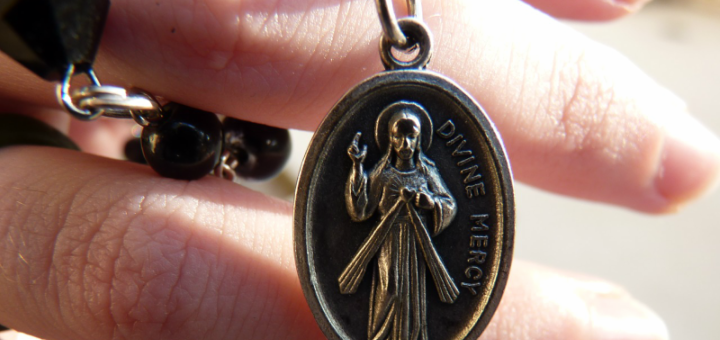
 Pixabay (2015), CC0 Public Domain[/caption]
Now that we're in the glorious season of Easter (Alleluia!), there are many wonderful traditions and feasts that we can celebrate. One such occasion is Divine Mercy Sunday, the feast which occurs on the first Sunday after Easter.
Officially decreed by the Holy See in 2000, Divine Mercy Sunday is a time in which the Church rejoices in the gifts of God's mercy and grace as men and women worldwide offer prayers of supplication and thanksgiving. Some churches hold special celebrations on Divine Mercy Sunday that include opportunities for Confession, Adoration, and praying the chaplet that is discussed in St. Maria Faustina's diary. Many of the festivities surrounding Divine Mercy Sunday focus on the need that we-as people who sin and turn away from God-have for God's mercy.
When I read The Diary of St. Maria Faustina Kowalska early on in my marriage, I fell in love with the message of God's intense mercy and love for us. I currently have a toddler, and my enthusiasm for St. Faustina and Divine Mercy has entered into our life at home, particularly as the Feast approaches. Recently, another woman asked me to explain my thoughts on teaching toddlers about the message of Divine Mercy, since toddlers -- being well below the age of reason -- are incapable of sin. I thought she brought up an interesting point. Since so much of the Divine Mercy message revolves around sin and redemption, why should we teach toddlers about it?
The more I thought about this devotion, though, the more I realized that within God's message of mercy, there are many areas we can concentrate on. We can indeed look at the beautiful depths of the love and salvation He offers to us when we sin. This area of focus may not make much sense to young children who do not have the mental capacity to willfully turn away from God.
Pixabay (2015), CC0 Public Domain[/caption]
Now that we're in the glorious season of Easter (Alleluia!), there are many wonderful traditions and feasts that we can celebrate. One such occasion is Divine Mercy Sunday, the feast which occurs on the first Sunday after Easter.
Officially decreed by the Holy See in 2000, Divine Mercy Sunday is a time in which the Church rejoices in the gifts of God's mercy and grace as men and women worldwide offer prayers of supplication and thanksgiving. Some churches hold special celebrations on Divine Mercy Sunday that include opportunities for Confession, Adoration, and praying the chaplet that is discussed in St. Maria Faustina's diary. Many of the festivities surrounding Divine Mercy Sunday focus on the need that we-as people who sin and turn away from God-have for God's mercy.
When I read The Diary of St. Maria Faustina Kowalska early on in my marriage, I fell in love with the message of God's intense mercy and love for us. I currently have a toddler, and my enthusiasm for St. Faustina and Divine Mercy has entered into our life at home, particularly as the Feast approaches. Recently, another woman asked me to explain my thoughts on teaching toddlers about the message of Divine Mercy, since toddlers -- being well below the age of reason -- are incapable of sin. I thought she brought up an interesting point. Since so much of the Divine Mercy message revolves around sin and redemption, why should we teach toddlers about it?
The more I thought about this devotion, though, the more I realized that within God's message of mercy, there are many areas we can concentrate on. We can indeed look at the beautiful depths of the love and salvation He offers to us when we sin. This area of focus may not make much sense to young children who do not have the mental capacity to willfully turn away from God.
 By Eugeniusz Kazimirowski (1873-1939) - http://www.cisza2.krakow.dominikanie.pl, Public Domain, Link[/caption]
However, the Divine Mercy devotion does not only highlight our sinfulness. In fact, at the root of God's abundant mercy is His deep, passionate love for every person. As Jesus explained to St. Faustina in her diary, "I am Love and Mercy Itself" (#1273). This is the reality that I try to show my toddler.
Since he's not even two years old yet, my son's comprehension of the intense love and mercy of God is rather limited. However, there are small ways that I've been introducing the message of mercy to him. For example, when my son sees a cross or picture of Jesus, I explain to him: "Jesus died on the cross for you, because He loves you so much!" One or two holy cards depicting the image of Divine Mercy move throughout our home, and my toddler will hold them and look at the picture of Jesus with the rays of mercy that shine forth. We've also read a poem about St. Faustina from Meghan Bausch's book, Saintly Rhymes for Modern Times (Our Sunday Visitor, 2018). Within the next couple years, as my son grows a little older, we may even do some hands-on crafts and coloring sheets that depict St. Faustina and the Divine Mercy image (try this one from CatholicMom.com contributors Emily Jaminet and Michele Faehnle). For now, though, introducing the Divine Mercy devotion in small and simple ways is what is working best for us.
We all need to hear the message of God's mercy and love. Even if our children cannot yet commit sins, they still can be introduced to this devotion. By teaching our children about Divine Mercy and bringing the image of Divine Mercy into our homes, hopefully we will be creating environments in which they can nurture deep and profound trust in God.
By Eugeniusz Kazimirowski (1873-1939) - http://www.cisza2.krakow.dominikanie.pl, Public Domain, Link[/caption]
However, the Divine Mercy devotion does not only highlight our sinfulness. In fact, at the root of God's abundant mercy is His deep, passionate love for every person. As Jesus explained to St. Faustina in her diary, "I am Love and Mercy Itself" (#1273). This is the reality that I try to show my toddler.
Since he's not even two years old yet, my son's comprehension of the intense love and mercy of God is rather limited. However, there are small ways that I've been introducing the message of mercy to him. For example, when my son sees a cross or picture of Jesus, I explain to him: "Jesus died on the cross for you, because He loves you so much!" One or two holy cards depicting the image of Divine Mercy move throughout our home, and my toddler will hold them and look at the picture of Jesus with the rays of mercy that shine forth. We've also read a poem about St. Faustina from Meghan Bausch's book, Saintly Rhymes for Modern Times (Our Sunday Visitor, 2018). Within the next couple years, as my son grows a little older, we may even do some hands-on crafts and coloring sheets that depict St. Faustina and the Divine Mercy image (try this one from CatholicMom.com contributors Emily Jaminet and Michele Faehnle). For now, though, introducing the Divine Mercy devotion in small and simple ways is what is working best for us.
We all need to hear the message of God's mercy and love. Even if our children cannot yet commit sins, they still can be introduced to this devotion. By teaching our children about Divine Mercy and bringing the image of Divine Mercy into our homes, hopefully we will be creating environments in which they can nurture deep and profound trust in God.
Copyright 2018 AnneMarie Miller
About the Author

AnneMarie Miller
A bibliophile, wife, mother of young children, and lover of the Liturgy, AnneMarie Miller enjoys exploring the manifold—and quirky—ways in which God speaks. She can often be found reading books to her kids, burrowing her toes in the red Oklahoma dirt, or sipping black coffee. Her reflections on Catholicism, literature, and hope can be found on her blog, Sacrifice of Love.


.png?width=1806&height=731&name=CatholicMom_hcfm_logo1_pos_871c_2728c%20(002).png)
Comments